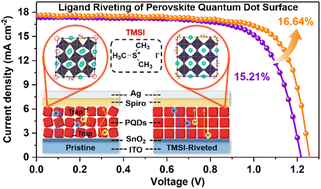Inhibiting lattice distortion of CsPbI3 perovskite quantum dots for solar cells with efficiency over 16.6%†
Abstract
Inorganic CsPbI3 perovskite quantum dots (PQDs) attracted tremendous attention for next-generation photovoltaics owing to their tunable surface chemistry and solution processability. However, the dynamically bound pristine ligands significantly suffer from dissociating from the PQD surface, and thus the intrinsic subtle lattices of PQDs are highly susceptible to distortion, dramatically affecting the long-range stacking and energy landscape of PQD solids. Herein, unfavorable [PbI6]4− octahedral tilts are effectively inhibited by riveting the aprotic trimethylsulfonium iodide (TMSI) ligand with an inverted triangular-pyramidal cationic structure into the vacancies of the PQD surface, which could leverage the steric effect to impart tensile strains from the PQD surface into the bulk. After riveting the TMSI ligands onto the PQD surface, the structural regularity, optoelectronic properties and stability of PQDs are substantially improved. Consequently, the PQD solar cell (PQDSC) yields an efficiency of up to 16.64%. The charge carrier dynamics within the PQDSCs are studied in-depth, which reveals that the remarkable performance of the PQDSCs is attributed to the oriented charge transport in the uniformly-packed PQD solid films with suppressed charge carrier recombination. This work provides new insight into the lattice-stabilization of PQDs through surface ligand engineering for high-performing optoelectronic devices.



 Please wait while we load your content...
Please wait while we load your content...